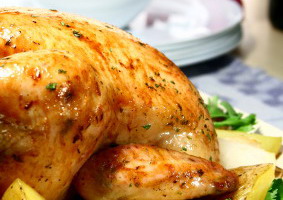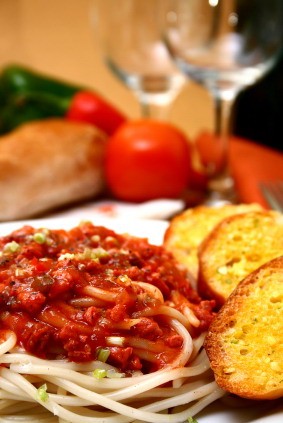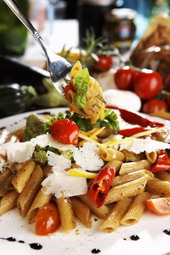Yes, I know that I’m supposed to be forward-looking to spring with a chirpy article about zesty white wines to pair with fresh vegetables, but it’s so cold outside … and I’m tired of writing seasonally-appropriate editorial content.
So let’s make wallowing fun, and turn to comfort wines paired with comfort food.
In our continuing video series with Canadian Press, we look at quick tips on pairing those old favourites, from braised meat to pasta in cream sauce with wine.
It’ll make you (almost) care what time of year it is when you have bottled sunshine.
Here are my favourite comfort red wines, comfort white wines, and of course, dessert wines.
Comfort Wines
Finally, I had an assignment that would give full vent to my scientific mind: To define and recommend “winter comfort wines” that would suit winter comfort activities.
The research would be vast. A breakthrough in this field would be bigger than cold fusion. I could envision my glorious future,  publishing my seminal book, On Comfort Wines, with a forward by Dr. Serge Renaud, the French scientist whose French Paradox studies established some of wine’s health benefits.
publishing my seminal book, On Comfort Wines, with a forward by Dr. Serge Renaud, the French scientist whose French Paradox studies established some of wine’s health benefits.
Snapping out of my reverie, I trot down to my laboratory — the wine cellar — to begin investigation. We’ve all heard about comfort food, but what about comfort wine?
After some experimentation in my cellar, I come to the discomfiting conclusion: few wines aren’t comfort wines. There are no uncomfortable wines or wines for discomfort; in fact, I find them all of great comfort.
How, then, to narrow the field? So I turn to previous papers put forward in the Comfort Wine Research Community with titles such as “The Wines of Winter,” “What to Drink When the Temperature Drops” and the incisive “Warm Tipples for Cold Nipples.”
Then I leaf through more magazines, and conclude that all winter wines are best consumed while chatting with friends in cable-knit sweaters by crackling fires, with Irish Setters at your feet. These  repeated images can not simply be coincidence or a collective lack of imagination.
repeated images can not simply be coincidence or a collective lack of imagination.
I decide to simulate this first winter comfort activity in a controlled environment (even though my scientific method was a little rusty: I had dropped all science courses in grade 12, choosing to take more marketable courses such as Russian literature and comparative world religion).
I spot a couple of neighbors out shoveling snow, and insist that they first go home, put on knitted sweaters, and come over.
We all sit in front of the fireplace, glowing radiantly: the temperature in the house is already 29oC, and the heat from the fire wafts over us in waves. While I pour, I explain that we are searching for wines that are familiar to us, since we usually equate comfort with the familiar.
I also mention that these wines wouldn’t be described as intellectual, and would probably not have aromas of wet violets. But they are not bland or unchallenging either – they resonate with deep, warm layers of fruit. My neighbors look at me curiously, but appreciate the free drinks.
We find a number of wines that fit this description — especially those from Australia, where a warm climate results in concentrated wines with lots of fruit.
Among the best were: Wynn’s Coonawarra Cabernet, Wolf Blass Grenache and Yalumba Shiraz. By this time, we have peeled off layers down to our t-shirts, but are finding great comfort in the wines.
This proves my first hypothesis: warm, jammy wines from Australia can be considered winter comfort wines, whether you’re wearing a  snuggly sweater or not. In the absence of an Irish Setter, a fluffy cat is an adequate substitute.
snuggly sweater or not. In the absence of an Irish Setter, a fluffy cat is an adequate substitute.
After the neighbours troop off, I get out a bottle of valpolicello, the quintessential easy-drinking wine, on the table.
My next hypothesis to prove was that not all winter wines have to be heavily extracted with high alcohol content — especially when you want to sip them over an evening, the winter equivalent of quaffing on the patio.
I concentrate on the bottle, and whisper my observations into a small dictaphone. Which winter comfort activity would pair well with sipping the wine?
I become unsettled with the strangeness of observing myself, so I decide to call Jay Stone, a movie critic — whom I do not know, but who happens to answer his phone — to get a movie recommendation.
Turns out he likes Il Postino (The Postman) — a happy coincidence since I just happened to be tasting several northern Italian reds. Masi Valpolicello and Ruffino Riserva Ducale Chianti Classico both complement the film’s warmth and intimacy with their rounded flavours of black cherries and plums with a smoky finish.
The second hypothesis is correct: low-alcohol wines are suitable winter wines, and the bonus is that you don’t end up believing yourself to be a minor character in the movie.
Now for my third hypothesis: Anyone can pair wine with food; but only those with too much time on their hands try to pair wine with literature.
 Looking at the books on the shelves, though, my eyes glaze over. Again I decide to call someone I don’t know: one is always better turning to experts for leisure matters. (That’s why wine writers are spreading faster than phylloxera).
Looking at the books on the shelves, though, my eyes glaze over. Again I decide to call someone I don’t know: one is always better turning to experts for leisure matters. (That’s why wine writers are spreading faster than phylloxera).
Michael Hall, of the Toronto bookstore Nicholas Hoare, suggests “One Hundred Years of Solitude.”
The story, by Gabriel Garcia Marquez, follows several generations of a Latin American family. So naturally I scour the shelves of the local liquor store for wines that are made in the novel’s setting — a small northern Columbian village called Macondo.
But after several hours of fruitless searching, a merchant is kind enough to tell me the village was fictional. He gently points me in the direction of Chilean wines.
I pick up several Chilean reds hoping to find aromas that will trigger the novel’s subtext — like Marcel’s memory-enhancing madeleine. Concha y Toro Cabernet Sauvignon and Errazuriz Merlot didn’t help with the textual analysis, but they did have a supple texture and lots of fruit up front.
Feeling pretty pleased with myself, in the name of science, I press on to my last hypothesis: Whether merlot is the only wine mellow enough for jazz music.
Local music expert Ann Lough suggests I listen to “All For You: A Dedication to the Nat King Cole Trio” by British Columbia native Diana Krall (Justin Time/GRP).
Krall’s music calls for something lush to complement the singer’s sultry voice, so I start with a Mission Hill Merlot, also from B.C. It works. But would a cab or a zin be equally jazzy?
Sumac Ridge Cabernet Franc and Cline Zinfandel work just fine too. I even try a little fizz with my frim-fram sauce: Domaine Chandon, Domaine Carneros and Iron Horse Brut from California. I had just opened up new vistas of vinous possibility for jazz lovers.
After a long day in the laboratory, it was time to write up my findings. I had discovered that while there are no uncomfortable wines, although some work especially well when you want something warmly familiar. But don’t take my word for it, prove it to yourself.
Posted with permission of the Canadian Press (CP).







